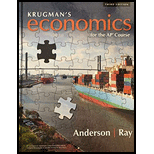
a)
The size of the change in government purchases that increased real
a)
Explanation of Solution
A change in government purchases will lead to a change in real GDP which would be equal to $200 million where MPC is equal to 0.75
Then,
Now,
Therefore, the government initially spent $50 million and here the multiplier effect would be raised through GDP by 200 million.
Introduction: The marginal propensity to consume refers to the proportion of the amount which is spent on the consumption of goods and services rather than keeping the amount as savings.
The spending multiplier represents the impact of change in autonomous spending on total spending and
And, a tax multiplier is used to identify the final increase in the level of real GDP with the change in tax rates.
b)
The value of the spending multiplier would increase real GDP of $200 million when the change in government purchases is $20 million.
b)
Explanation of Solution
When the value of the spending multiplier would lead to an increase in real GDP of $200 million where the government spending on goods and services is changed by $20 million, then the value of this spending multiplier would be:
Therefore, the initial multiplier was 10 in this case.
Introduction: The marginal propensity to consume refers to the proportion of the amount which is spent on the consumption of goods and services rather than keeping the amount as savings.
The spending multiplier represents the impact of change in autonomous spending on total spending and demand in the economy of the country, which may increase or decrease.
And, a tax multiplier is used to identify the final increase in the level of real GDP with the change in tax rates.
c)
The marginal propensity to save would have led to that value of the spending multiplier.
c)
Explanation of Solution
When the marginal propensity to save led to that value of the spending multiplier, then it would be:
1/(1-MPC) = 10
Then, the marginal propensity to save would be 0.9.
Introduction: The marginal propensity to consume refers to the proportion of the amount which is spent on the consumption of goods and services rather than keeping the amount as savings.
The spending multiplier represents the impact of change in autonomous spending on total spending and demand in the economy of the country which may increase or decrease.
And, a tax multiplier is used to identify the final increase in the level of real GDP with the change in tax rates.
Chapter 21 Solutions
Krugman's Economics For The Ap® Course
- Published in 1980, the book Free to Choose discusses how economists Milton Friedman and Rose Friedman proposed a one-sided view of the benefits of a voucher system. However, there are other economists who disagree about the potential effects of a voucher system.arrow_forwardThe following diagram illustrates the demand and marginal revenue curves facing a monopoly in an industry with no economies or diseconomies of scale. In the short and long run, MC = ATC. a. Calculate the values of profit, consumer surplus, and deadweight loss, and illustrate these on the graph. b. Repeat the calculations in part a, but now assume the monopoly is able to practice perfect price discrimination.arrow_forwardThe projects under the 'Build, Build, Build' program: how these projects improve connectivity and ease of doing business in the Philippines?arrow_forward
- Critically analyse the five (5) characteristics of Ubuntu and provide examples of how they apply to the National Health Insurance (NHI) in South Africa.arrow_forwardCritically analyse the five (5) characteristics of Ubuntu and provide examples of how they apply to the National Health Insurance (NHI) in South Africa.arrow_forwardOutline the nine (9) consumer rights as specified in the Consumer Rights Act in South Africa.arrow_forward

 Principles of Economics (12th Edition)EconomicsISBN:9780134078779Author:Karl E. Case, Ray C. Fair, Sharon E. OsterPublisher:PEARSON
Principles of Economics (12th Edition)EconomicsISBN:9780134078779Author:Karl E. Case, Ray C. Fair, Sharon E. OsterPublisher:PEARSON Engineering Economy (17th Edition)EconomicsISBN:9780134870069Author:William G. Sullivan, Elin M. Wicks, C. Patrick KoellingPublisher:PEARSON
Engineering Economy (17th Edition)EconomicsISBN:9780134870069Author:William G. Sullivan, Elin M. Wicks, C. Patrick KoellingPublisher:PEARSON Principles of Economics (MindTap Course List)EconomicsISBN:9781305585126Author:N. Gregory MankiwPublisher:Cengage Learning
Principles of Economics (MindTap Course List)EconomicsISBN:9781305585126Author:N. Gregory MankiwPublisher:Cengage Learning Managerial Economics: A Problem Solving ApproachEconomicsISBN:9781337106665Author:Luke M. Froeb, Brian T. McCann, Michael R. Ward, Mike ShorPublisher:Cengage Learning
Managerial Economics: A Problem Solving ApproachEconomicsISBN:9781337106665Author:Luke M. Froeb, Brian T. McCann, Michael R. Ward, Mike ShorPublisher:Cengage Learning Managerial Economics & Business Strategy (Mcgraw-...EconomicsISBN:9781259290619Author:Michael Baye, Jeff PrincePublisher:McGraw-Hill Education
Managerial Economics & Business Strategy (Mcgraw-...EconomicsISBN:9781259290619Author:Michael Baye, Jeff PrincePublisher:McGraw-Hill Education





